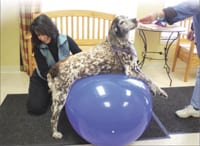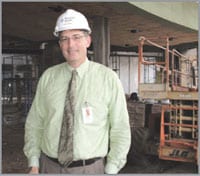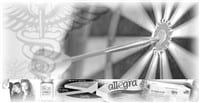Canine Lives This East Longmeadow Rehabilitation Center Is for the Dogs
Cody, a German shepherd, was about 7 years old at the time. He couldn’t jump in the car anymore. He couldn’t go on long walks, he limped, and he seemed generally depressed.
“There was some pain involved, and through a veterinary exam, the dog was diagnosed with hip problems and was a possible candidate for hip surgery,” said Bev Savoie, director of physical rehabilitation services at New England Canine Rehabilitation & Fitness Center (NECRFC) in East Longmeadow. “But the owners wanted to do something less invasive. At that time, recovery from that type of surgery wasn’t 100{06cf2b9696b159f874511d23dbc893eb1ac83014175ed30550cfff22781411e5}, so they wanted to try rehab first.”
After a few months of hydrotherapy and other treatments offered at Savoie’s practice, Cody had regained most of his function. “He could jump in the car again, jump up on the bed, run up and down the stairs, and take long walks. He was no longer lame and no longer a candidate for hip surgery. He was an overall happy dog.”
Such stories warm the heart of Savoie, who is at the forefront regionally of the growing field of canine rehabilitation and hydrotherapy.
“It’s the most gratifying job I’ve ever had,” she said. “Being able to give people the tools to help their dogs, and being able to extend their lives, is priceless. We do it for the dogs; that’s why we’re all here. We love dogs, and they deserve this type of treatment, because it does prolong their lives.”
Go with the Flow
Savoie joined NECRFC part-time in 2003, not long after it opened, and learned the business though one of its founders, Kristin DeLuca, before enrolling in the Canine Rehabilitation Institute in Loxahatchee, Fla. When DeLuca left to open another clinic closer to where she lived, Savoie stepped into a management role. Around 2006, the business moved from Boston Road in Springfield to its current facility on Shaker Road.
“The primary aspect of what we do is hydrotherapy, which includes walking on an underwater treadmill and swimming in an inground lap pool about 30 feet long,” she told HCN. “We also have a whirlpool that we use sometimes after we do massages. It helps stretch the joints; the spaces open up wider in the water to get a range of motion.”
The clinic also offers electrotherapeutic modalities, including cold-laser therapy, therapeutic ultrasound, and electrical stimulation, as well as targeted physical exercises. Dr. Bud Allen, co-owner of Family Veterinary Center in Haydenville, stops by once a month to provide acupuncture and chiropractic evaluations and treatments.
Many of the dogs treated at NECRFC have recently undergone orthopedic surgery on the shoulder, elbow, or knee, and many dogs — like Cody — use the services in place of surgery. “Sometimes surgery is not an option, or a client doesn’t want elective surgery. So we try to help these conditions through rehabilitation,” Savoie said, stressing that they don’t call what they do ‘physical therapy,’ a term that requires a different set of certifications, even though many of their services resemble physical therapy in humans.
“Sometimes a dog has a condition that makes it not suitable for surgery; it could be the age of the dog or a heart condition. Some people either can’t afford surgery or just think it’s too invasive.”
For dogs who are undergoing surgery, “sometimes vets will send dogs to us before the surgery to build up more body condition and decrease the amount of muscle atrophy that will happen as the result of surgery,” she continued.
“If the dog goes into surgery more well-built, then the recovery time is quicker, and the muscle atrophy is less. It also decreases the chances of a compensating injury on the opposite leg. You can’t ever get the chance of that down to zero; dogs are dogs, and they like to run and chase squirrels, but you do the best you can and try to protect them as much as you can.”
In addition, some clients come in when their dogs are older and arthritic, finding that a couple months of treatment relieves their joint aches. “People always say, ‘my dog’s back to his old self,’” Savoie said. “It’s a really big component of what we do.
“We also teach dogs how to swim,” she added, noting that, while most dogs are natural swimmers, some need help early on. “It’s great exercise, and they can go do it for free during the summer, then come back for our swim club in the winter.”
Savoie has another passion at the clinic as well — trying to reverse the trend of overweight dogs, which tend to suffer from shorter lifespans, often significantly so.
“People just aren’t getting any guidance aside from what the dog-food manufacturers put on the back of the package for how much dogs need to eat,” she said. “So they end up overfeeding; often they’re giving almost double the quantity of food they need, in addition to overtreating and feeding from the table.”
She works with the owners of overweight dogs to determine how many calories they should consume in a day and the healthiest kinds of food and treats for each animal.
That effort eventually morphed into a lighthearted — yet serious, given the stakes — program based on the TV show The Biggest Loser, where participating dogs weigh in every week, and their owners get a quick consultation to track the dog’s progress. The winner — er, loser of the most weight — takes home $125, and second prize is a gift basket.
“I help them with the amount of food to give and the exercises they can do at home,” Savoie said, adding that some also order up a package of swimming or treadmill activity at the center, depending on what they can afford. “I had 10 dogs take part, and all but two have been losing anywhere from a pound or two a week to a pound every two weeks. It’s easier for some than others, but everyone’s really trying. The dogs are looking phenomenal.”
Driving Business
Since canine rehab isn’t as urgent as, say, emergency veterinary care, the business certainly isn’t immune to shifts in the economy, and the recent downturn has been a factor, Savoie said.
“We used to see up to 70 or 80 dogs in a week. That dropped off when we moved, but we built it up again. Then, when the economy faltered and gas prices increased, we saw a definite decrease. People didn’t want to drive this far; we had people driving an hour and half to get here. But it’s turning around. Since we opened a swim club, we’re seeing more than 90 dogs a week. That’s huge growth; the last quarter has been amazing.”
In general, awareness of the value of such services is definitely on the rise, she added. “We get a good share of referrals from vets; a lot of vets are becoming more aware of our services, and as time goes on and our clients go back for their yearly exams, they’re starting to see the benefits of doing this. The dogs are stronger; the older, arthritic dogs are able to get up and move. Vets are starting to get on board. And veterinary schools are starting to offer courses in rehab, so that eventually it will become a specialty for vets.”
Meanwhile, the benefits of canine rehabilitation have been touted on Animal Planet, and word has spread through the dog-sports world, particularly agility leagues. “More rehab centers are popping up all over the country,” Savoie added. “They’ve been doing rehab for horses for years, and it’s finally gravitating to dogs. And every once in a while, I get a call about a cat. They can go on the treadmill — although they tend to not like the water.”
Speaking of which, many dog owners have reported that their pets had an aversion to water before being treated at NECRFC, and now they love it. Cody was one of them; “we still have his claw marks in one of our mats,” Savoie said, from when he dug in when it was time for the pool. “But eventually he loved it. He’d run from one end of the building to the other to get to that pool.”
Cody eventually returned to the center with neurological problems later in life; although the condition was incurable, rehab allowed him more quality years with his family at the end. And extending life, Savoie said, is one of the most satisfying things she and her staff do.
“One dog had a bilateral cruciate rupture and couldn’t walk. The vet said this might be the end,” she said. “But that dog started walking — not well, but walking — after a couple of treatments.”
Now, years later, the dog has multiple issues, but he’s still around, to the delight of the couple who owns him. The husband told Savoie that his wife and the dog were so bonded that he didn’t know what she would have done had she lost the dog after his injury. “It was a hard time in that person’s life; she’d gone through a lot of loss. But the dog is still living at 16.”
That’s the essence of rehab: not just adding years, but improving them. And with dogs’ lives so short to begin with, that’s nothing to growl at.




Comments are closed.